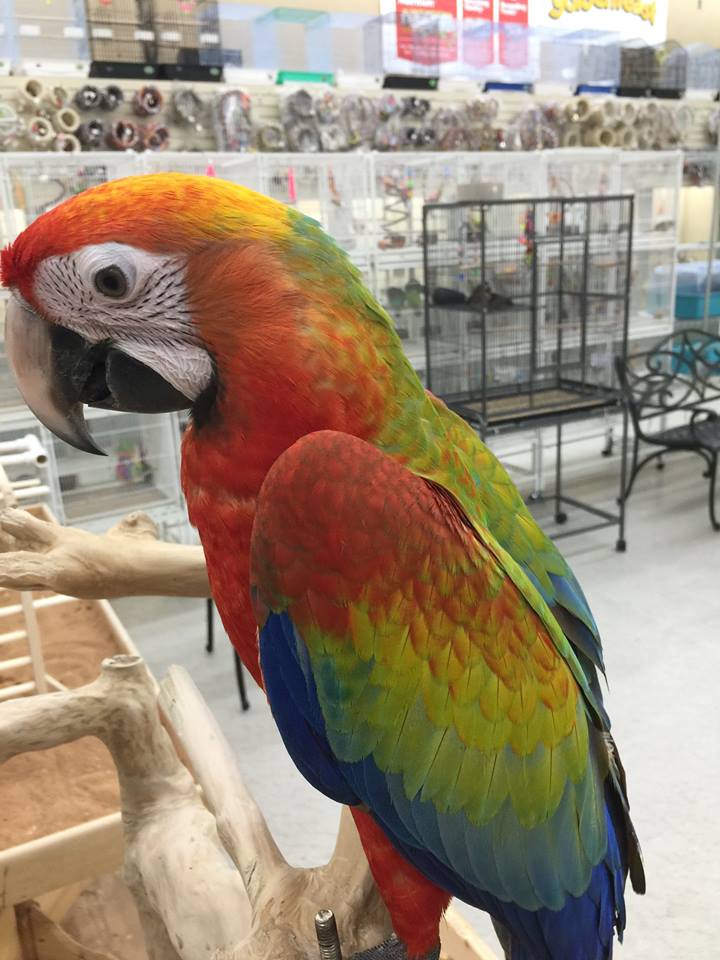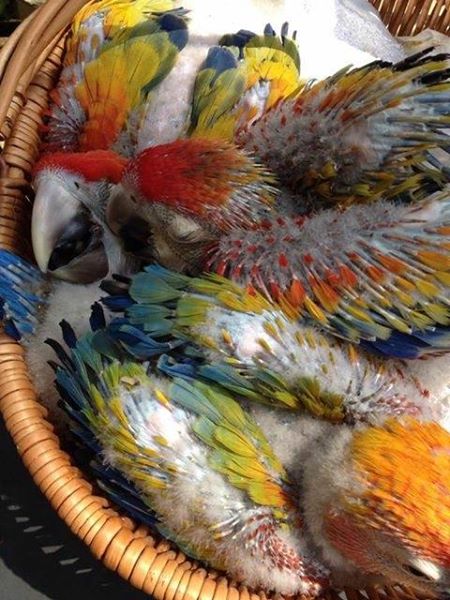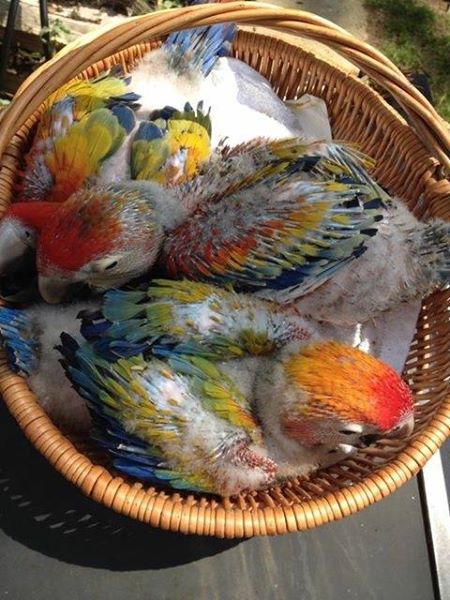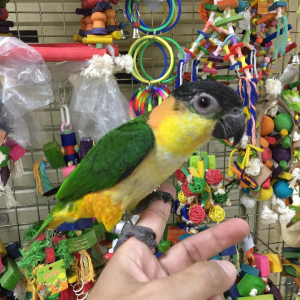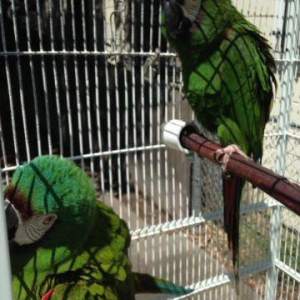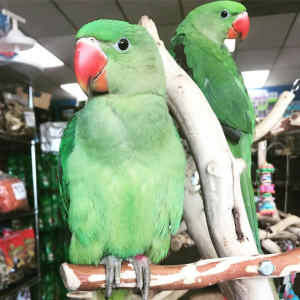Paleo Hybrid Macaws For Sale online
Paleo Hybrid Macaws, The Paleo Macaws for sale are 4th generation Scarlet macaw hybrid offspring of yellow dominant Capri macaw x Scarlet macaws. Hybrid Macaws are bred for their amazing coloring. They can be very attractive but keep in mind, they are still Macaws. As a Macaw owner you will reap many fine benefits. All Macaws are extremely beautiful, but temperaments and behavior will vary from one bird to the next, and they do require good socialization.
Sometimes Macaw hybrids are touted as being exceptional parrots because of their appearance. However the same considerations apply when obtaining one of these beauties as applies when obtaining any Macaw. Macaws are a long lived pet birds that have particular requirements and need a dedicated keeper.
Being a mixture of more than one type of Macaw, the temperament and behavior of each hybrid will be uncertain. A hybrid will be influenced by both of its parents’ traits, but will often be more like one parent than the other. Learn about the characteristics of both its parents to understand what type of behaviors and temperament your pet may demonstrate. Be sure you are comfortable with keeping and handling either type of the parent Macaws, so that you will be competent and comfortable handling the offspring.
What are Hybrid Macaws?
- Hybridization
Hybrid Macaws are typical Macaws, but they are not pure species Macaws. A hybrid Macaw parrot is basically the result of crossing two different Macaw species. Those produced by two different species within the same genus are sometimes known as ‘inter-specific hybrids’ or ‘crosses’. Hybrids between different sub-species, within a species, are known as intra-specific hybrids. - Mutation
There is a difference between breeds developed through mutation and the hybrid Macaws. Mutation is where a single species is developed for particular characteristics such as size, coat, color, temperament, and so on. Dogs breeds, domestic cats, rabbit breeds, and even horse breeds are examples of mutations. These animal are all developments of the same species, they are not the result of crossings with other species or subspecies.
Hybrid Macaw Breeding
Most hybrid animals produced in nature, Macaws or otherwise, do not always persist. There are a number of factors in nature that limit the success of hybridization. One limiting factor involves coloration. Many hybrid animals are more colorful than their parents, so they stand out and become easy prey for predators. For many animals the offspring, or hybrids, produced from genetically dissimilar parents are sterile. However this is not so with Macaws. Paleo Hybrid Macaws.
- Hybrid Macaws in Nature
Generally Macaws will only mate with their same species due to natural barriers, mating behaviors and cues, as well as other physical or biological limitors. However, hybrid Macaws do occasionally occur in the wild. A natural Macaw hybridization that produced a lot of interest, a cross between the last known surviving male Spix’s Macaw Cyanopsitta spixii and a female Illiger’s Macaw Ara maracana, was reported in the academic publication, Conservation Genetics, printed in the Netherlands in 2001.This natural hybrid occurrence created quite a stir because the Spix’s Macaw is critically endangered with extinction. Since about the time of that publication there have been no more citing’s of the Spix’s Macaw in the wild. There is good news though, currently there are now close to 150 species of this Macaw in an international, cooperative captive breeding program.There is concern about Macaws in the wild. The aviculture of many Macaw species is not only desirable but essential to safeguard their future. Successes in aviculture, the captive breeding of Macaw species held in captivity, has benefited the wild populations. Trade of wild caught birds of these species has almost stopped and for most of these species, their future looks secure. There has also been some re-introduction of species, but that is still in a very experimental stage.Unfortunately the numbers of some Macaw species are still dwindling due to habitat destruction. Macaws are great travelers and utilize extensive forest areas for foraging and nesting. Deforestation can create smaller, isolated areas, resulting in reduced populations. When Macaws are isolated from each other by a fractured range,this can cause other long term problems to develop, including inbreeding and losses of genetic variability. The future hybridization of Macaws in the wild may increase. - Hybrid Macaws in Captivity
Hybridization of Macaws in captivity was often the result of accident where two species of Macaw kept in the same environment, bonded and produced offspring. Macaw breeding to produce hybrids for the pet trade has resulted due to the current interest and popularity of these birds. These hybrids are often very beautiful birds with distinct coloration. Some varieties of hybrid Macaw are second or third generation birds, or even more.
The result of hybridization for many species is sterile offspring. But that is not true of first generation F1 Macaw hybirds, and usually second generation F2 Macaw hybrids are also not sterile. It is interesting to note however, that there is reportedly a higher rate of sterility in third generation F3 hybrids and on. This may be why we aren’t seeing an influx of fourth generation F4 Macaw hybrids.
Characteristics of Macaw Hybrids
- Hybrids Colors
Macaw Hybrids have been traditionally bred for color. The father’s have the dominant gene, so this will generally influence the offspring’s appearance. However some say that the sex of the offspring my also influence the color, with a female offspring tending to take on the color traits of the father while the male offspring tends to take the those of the mother. - Hybrid Personalities
One of the challenges with the cross breeding of the hybrids has been a tendency for the coloring to get muddied. This has been found primarily on some of the third generation crosses and deeper crosses, and occasionally even on some second generation birds. As for their temperament and behavior, these characteristics are uncertain. Hybrids seem to inherit traits of both parents, though often more strongly those of one parent or the other. - Macaw Hybrid Names
Unlike the scientifically described species of animals found in nature, there are no scientific names for hybrid Macaws. They are primarily recognized is as a cross between ‘this’ and ‘that’. The assignment of common names, however, has a similar history to the common names for scientifically described species animals. Common names, though often derived from the scientific name, are just as easily coined because of a location or because of physical descriptions like color or patterning. This is equally true of some common names concocted for scientifically described species. A name is often used by one person, and then used by others and becomes recognized as an accepted name.The names of hybrid Macaws are quite beautiful and descriptive, such things as ‘capri’, ’emerald’, ‘rainbow’, ‘ruby” and ‘shamrock’ are what we see. Usually someone begins calling their hybrid something descriptive. Then another person uses the same name to describe the cross. This starts to become the ‘common’ or accepted name. Some of the most familiar hybrids have well recognized common names, while many of the hybrids are still ‘becoming’, in terms of their common names.
Hybrid Macaw Types
Hybrid Macaws are considered to be either a 1st generation, 2nd generation, 3rd generation bird, or can be even more. The term “filial”, represented by the letter “F” is used to classify the type of hybrid. It refers to a sequence of generations following a parental generation. So an F1 or 1st generation Macaw, is one generation from the parent, and F2 is two generations away from the parent generation, and so forth.

